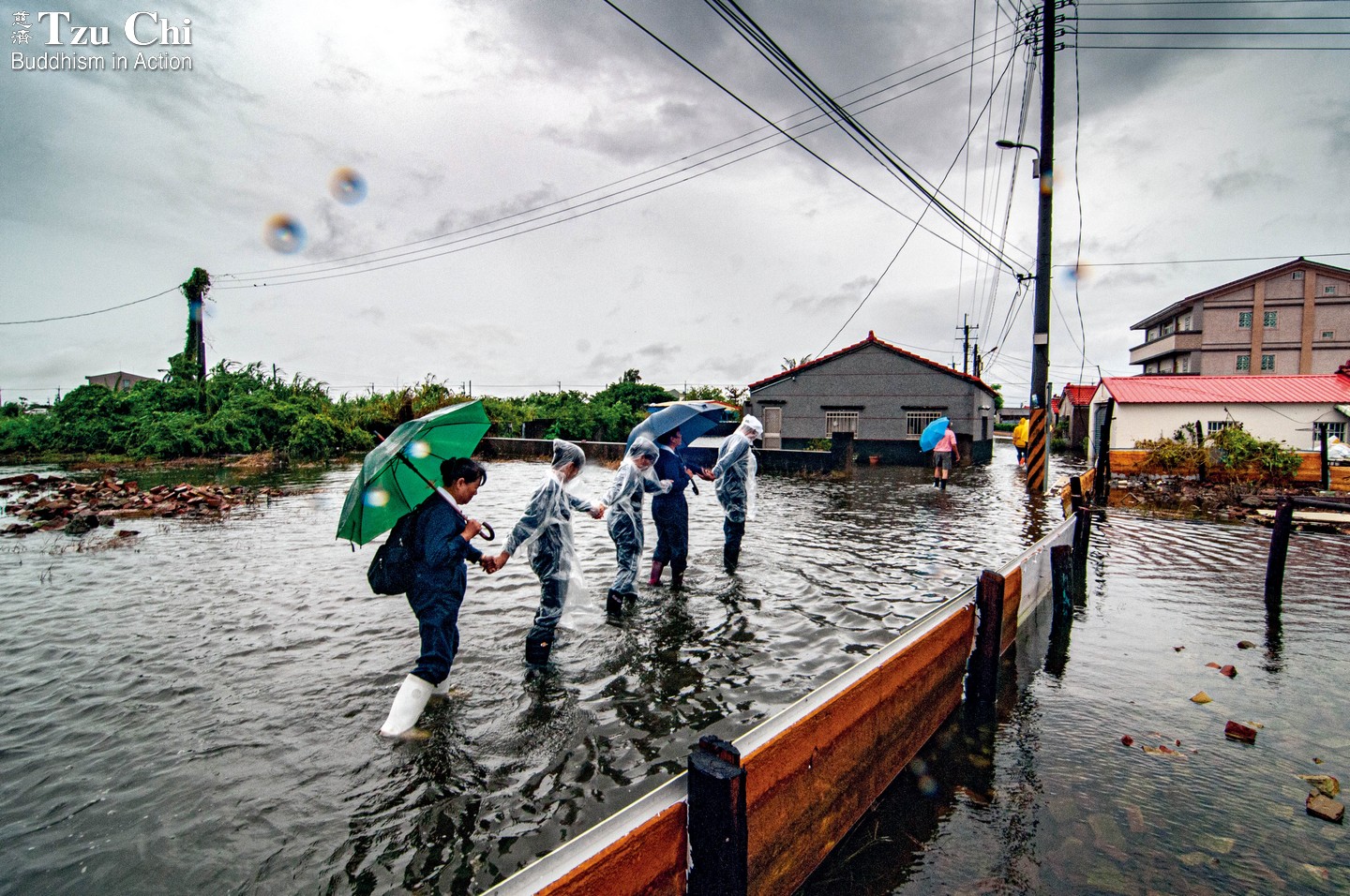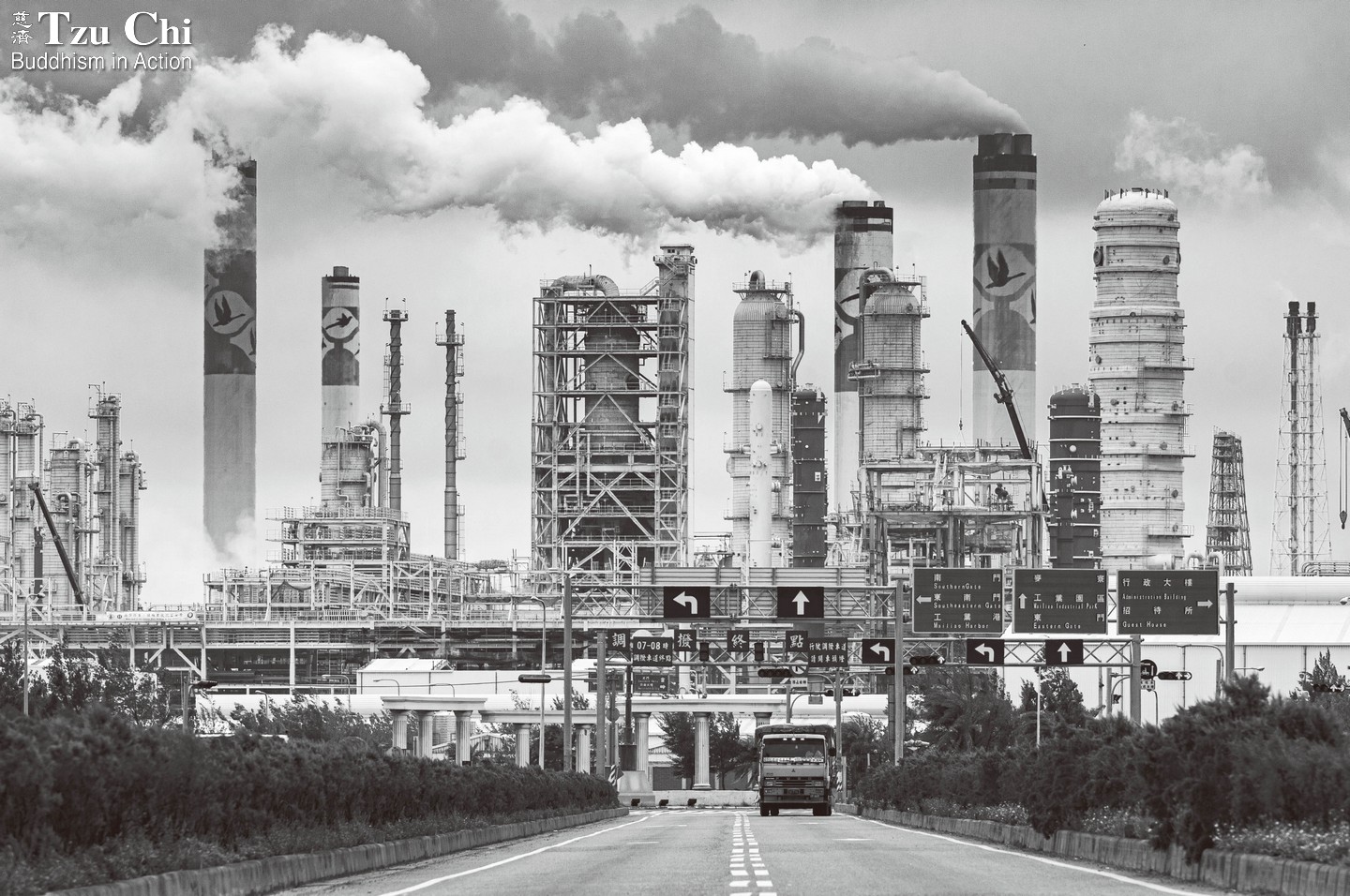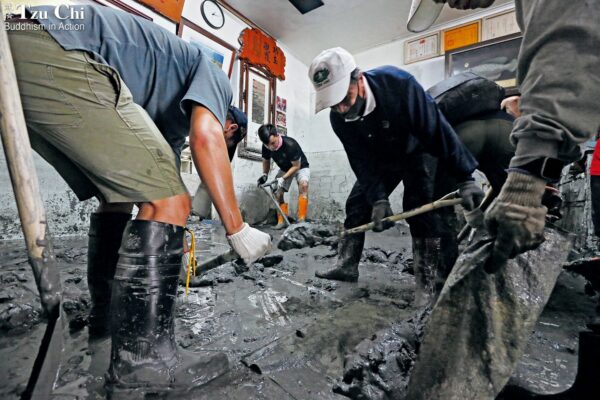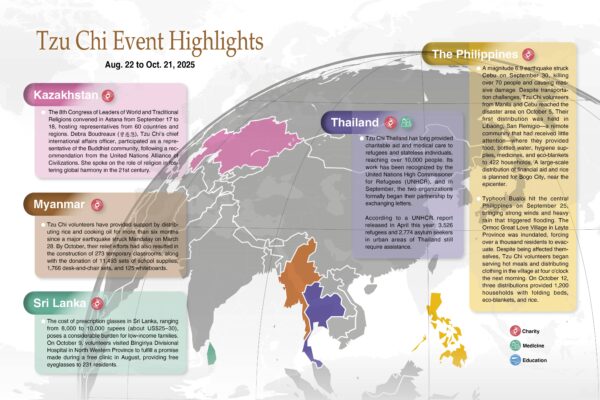By Yeh Tzu-hao
Translated by Wu Hsiao-ting
Photos by Huang Xiao-zhe
Our world is experiencing the hottest period in recorded history. Countries around the world have pledged to achieve net zero emissions by 2050 in an effort to limit global warming to 1.5 degrees Celsius and prevent the worst impacts of climate change. What we do today will determine the future of the Earth.

Trees form an important part of the carbon cycle. When more carbon dioxide is released into the atmosphere than natural processes can remove, the impact can last a thousand years.
A young married couple, toddler in tow, is enjoying nature up close in a forest recreation area in Taiwan. The little girl tightly clutches her dad’s index finger in her tiny fist, looking curiously and a little timidly at the towering trees lining their path. The sight of her bright, round eyes exploring the world, her steps tottering, makes people smile. What a happy scene; what a beautiful, peaceful world.
But the beauty and peace of the world cannot be taken for granted. How long can it last?
In fact, the world is more fragile than we might imagine. Take Taiwan for example. The island has suffered a severe storm-induced disaster every three years on average since 2000. Rainfall is uneven. Extreme warm and cold weather events have become even more pronounced.
At the same time, the global mean temperature has been hitting new highs. According to a report issued by the United Nations’ World Meteorological Organization in May 2022, the past seven years have been the warmest seven years on record. The report also pointed out that four key climate change indicators—greenhouse gas concentrations, sea level rise, ocean heat, and ocean acidification—all set new records in 2021. The melting of polar and glacial ice is causing sea levels to rise. High temperatures and reduced rainfall have kindled unprecedented, raging wildfires.
Twenty or 30 years from now, when today’s toddlers have reached their 20s or 30s and are visiting a natural area with their own children, what will they be seeing? Will it still be a scene of beauty and peace?

Extreme weather events, such as sudden heavy rainfall, have been occurring with a greater frequency in Taiwan over recent years. This photo shows flash floods in Chiayi, southern Taiwan, caused by such cloudbursts in August 2018.

The largest source of greenhouse gas emissions worldwide is the use of fossil fuels. Hsiao Yiu-hwa
It’s now or never
Carbon dioxide emitted as a result of human activity is fueling the increase of extreme weather events and natural disasters around the world. Faced with the climate crisis, nearly 200 countries attending the 2021 United Nations Climate Change Conference (also known as the COP26), signed the Glasgow Climate Pact at the annual climate summit held in Glasgow, Scotland. All participating countries agreed to adhere to the 2015 Paris Agreement and pursue efforts to limit the global temperature increase to 1.5 degrees Celsius above pre-industrial levels. More than 130 countries pledged to reach net zero emissions by 2050.
Human activities emit greenhouse gases, most notably carbon dioxide and methane. These gases cause global warming by trapping the sun’s heat in the atmosphere. Net zero refers to a state in which greenhouse gas emissions released into the atmosphere are balanced by an equivalent amount absorbed or removed from the atmosphere. Carbon emissions can be captured by natural means—trees being the classic example—or through artificial interventions, such as carbon capture technologies.
Currently, 30 billion tons of carbon dioxide are being released globally into the atmosphere per year. With these quantities going into the air, achieving net zero emissions is a tough challenge. However, if we fail to take major action to reduce emissions, the global temperature is on track to rise by about 3.2 degrees Celsius by 2100, resulting in disastrous consequences. “It’s now or never, if we want to limit global warming to 1.5°C [2.7°F],” said Jim Skea, the co-chair of Working Group III of the United Nations’ Intergovernmental Panel on Climate Change. “Without immediate and deep emission reductions across all sectors, it will be impossible.”
If we compare the Earth to a damaged ship in need of major repairs, cutting emissions is the most urgent task if we want to prevent it from sinking any further, if we want to ensure that humanity has a future.
The first order of business in cutting emissions to zero is to reduce our dependence on coal, oil, natural gas, and other fossil fuels. It’s also essential to transition to a circular economy. According to the United States Environmental Protection Agency, “A circular economy reduces material use, redesigns materials to be less resource intensive, and recaptures ‘waste’ as a resource to manufacture new materials and products.” Only when governments, industries, and individuals work together to reduce waste and greenhouse gas emissions will it be possible to balance economic development and environmental sustainability.
Even though it is difficult for our world to eliminate completely its dependence on fossil fuels, the governments of many nations and international or non-governmental organizations (NGOs) have taken influential action to address the climate change issue. For examples, countries in the European Union reached an agreement in March this year on the Carbon Border Adjustment Mechanism (CMAB) regulation, planning to levy a world-first carbon dioxide emissions tariff on the importation of polluting goods, starting in 2026. Put simply, importers will be required to purchase CBAM certificates corresponding to the embedded emissions in their imported goods. This measure essentially reduces the competitiveness of carbon-intensive goods in the European Union.
The financial sector has also joined in efforts to address climate change. Banks and investors, for example, are pledging to shift their funding in ways that help reduce carbon emissions. In Taiwan, the Financial Supervisory Commission under the Ministry of Finance issued in March this year a road map of sustainable development for Taiwan’s listed corporations. The plan requires all listed companies to disclose their greenhouse gas inventories by 2027 and to verify such inventories by 2029. This is an effort towards energy saving and carbon reduction.

Tzu Chi volunteer Huang Ju-zi (黃菊子) picks up trash washed up on a beach in Tainan, southern Taiwan, her bag filling quickly. Reducing the production of garbage at the source is the key to lessening its impact on the environment.
Carbon reduction becomes a must
As the international community ramps up greenhouse gas mitigation efforts, environmental issues have moved from the wings to center stage for nations and companies around the world. Bill Gates summarized the reason for this shift in his book How to Avoid a Climate Disaster: “The countries that build great zero-carbon companies and industries will be the ones that lead the global economy in the coming decades.” Taiwan, with its high reliance on exports, is among the economies that must step up their carbon reduction efforts. Companies that fail to measure up to international environmental standards risk failing in the open market, further impacting a country’s overall economic competitiveness.
It’s not just the manufacturing industry that faces the challenge of carbon neutrality—the same goes for the transportation sector.
Tzu Chi volunteer Denghsien Yeh (葉燈憲) is in charge of fleet management at an airline company. He said he and others in his company are working to reduce the weight of aircraft and increase the efficiency of engines to optimize transportation efficiency. “In the future, all flights heading to Europe have to meet EU’s environmental protection demands,” Yeh said. He opened his company’s sustainability report, which includes a comprehensive list of the airline’s energy-saving and carbon-reduction measures. Their actions run the gamut from retiring gas-guzzling older aircraft to going digital as much as possible to cut the usage and waste of paper.
As a result of the international community’s consensus to promote a transformation to carbon neutrality, the survival and development of enterprises, nations, and societies is now inextricably linked to their efforts to reduce carbon emissions. However, in Taiwan, more than 80 percent of power still comes from burning fossil fuels. This accounts for more than 170 million tons of greenhouse gas emissions per year. Power that comes from renewable energy sources, such as solar and wind, comes to less than seven percent.
Since most businesses on the island still rely on traditional energy sources with a high carbon footprint, their transition to net zero emissions will be a tougher challenge. This further puts them at a disadvantage with their competitors on the international market.
In order to keep up with the international competition and push the transition to a net zero future, Taiwan’s National Development Council (NDC) in March 2022 presented a road map for Taiwan to achieve net-zero emissions by 2050, along with an explanation of an overall strategy. The NDC said that working on climate legislation and technology R&D, and through a combination of renewable energy, power saving, resource recycling, and green living tactics, the government will advance a broad transition across Taiwan’s energy sector, industry, lifestyle, and society to allow the island to become a net zero green economy before 2050.

Students at Tainan Tzu Chi Senior High School in southern Taiwan take a nap at noon in a classroom designed to optimize ventilation, which reduces the need for air-conditioning.
No one is an outsider
Whether it is to fulfill an enterprise’s social responsibility or a strategy to remain economically viable, many company owners and managers have worked to broaden their knowledge of environmental protection. They’ve enlisted the help of experts to take greenhouse gas inventories of their companies and plan courses of action to move their companies in the right direction. They have similarly asked their supply chains to take action.
Compared to the strict demands placed on the manufacturing and transportation sectors, the international community has not yet required non-profit charitable organizations, hospitals, or schools to achieve net zero emissions. Even so, Tzu Chi, one of the largest NGOs in Taiwan, has announced its goal to reach net zero carbon emissions. This is a natural continuation of the foundation’s environmental efforts, its care for the Earth, and a strong sense of commitment to bring about a better world. Tzu Chi’s leadership in this area was initiated more than three decades ago, when Dharma Master Cheng Yen called on everyone to recycle.
Tzu Chi’s hospitals and schools have been designed using green architecture approaches. Buildings were planned to optimize ventilation and reduce exposure to sunlight to cut down on the use of electricity, and rainwater recycling systems were installed to conserve water resources. Environmental education has made Tzu Chi volunteers particularly eco-conscious. They not only endeavor to reduce their own carbon footprint, but also to spread the word on the importance of environmental preservation.
Tzu Chi’s environmental efforts over the last 30 years have won recognition from the Taiwanese government and the international community. Both Tzu Chi Dalin Hospital and the Tzu Chi University of Science and Technology received a National Environmental Education Award in 2013 for their efforts in promoting environmentalism. The Tzu Chi Foundation, Tzu Chi Senior High School, and Jer Lin Chen (陳哲霖), a Tzu Chi environmental education lecturer, were recognized with the same award this year.
Before Taiwan’s government announced its determination to achieve net zero emissions by 2050, Tzu Chi had already laid a recognizable foundation for Taiwan’s society to advance in that direction. The foundation announced in 2021 its goal to reach net zero emissions by 2050. Its plan to attain that goal consists of taking a greenhouse gas inventory of the foundation, analyzing current emission levels, and then formulating and taking actions to offset those emissions. When the inventory statistics are out, specific goals will be set for 2030, 2040, and then 2050 to gradually reach the holy grail of net zero.
Jer Lin Chen, a National Environmental Education Award winner this year, advises everyone, whether they work for the government or a private enterprise, not to view the mission to achieve carbon neutrality as yet another arduous task to tackle, but instead set their sights on the future. When they take the long view, they will better understand the value of their efforts. “Is the purpose of net zero emissions to save the Earth or human beings?” Chen explained. “It’s humanity who is seeking sustainability. If we work to reduce emissions with our children and grandchildren in mind, we’ll meet the challenge a lot more willingly.”
Tzi-Chin Chang (張子敬), who heads Taiwan’s Environmental Protection Administration, stresses the importance of starting with oneself when it comes to responding to climate change. “How can we achieve net zero emissions by 2050?” he asked. “One important item is behavioral change. Our careless behavior has resulted in the generation of a lot of carbon dioxide emissions or the waste of many resources. That’s why in our country’s road map to net zero, there is an approach called ‘green living.’ If we all work together, we’ll achieve very good results.”
A carbon reduction road map released by the United Nations in April this year also pointed out how behavioral and lifestyle changes can quickly reduce end users’ yearly greenhouse gas emissions by at least five percent globally. In other words, everyone can contribute to carbon neutrality by adjusting their lifestyles. Examples include adopting a vegetarian diet, preventing food waste, avoiding excessive consumerism, reducing the use of air-conditioning and heating, buying durable and reparable products, and using car-sharing services.
Human beings have inflicted much damage to the environment, and climate change and global warming are becoming worse. And yet, if individuals, enterprises, governments, and nations across the world are all willing to do what they can to reverse the trend, the world’s future might not be as bleak as climate experts have predicted.
Just as Sundar Pichai, CEO of Google and Alphabet, said, “Meaningfully reducing carbon emissions will take big, bold moves and small, meaningful changes.” On the large scale, it can involve an entire nation; on a smaller scale, an individual. Whether it is systematic, across-the-board transformation at the national level, or small, personal changes, such as avoiding one-use items, all of us play a part in determining our future. The power of change is in our hands.

A mother and her two children riding a Taipei Metro train look out a window at Mount Guanyin in New Taipei City, northern Taiwan. Only when humans can coexist in harmony with nature will a convenient, comfortable lifestyle last. It takes everyone’s participation to reach the goal of net zero carbon emissions.



